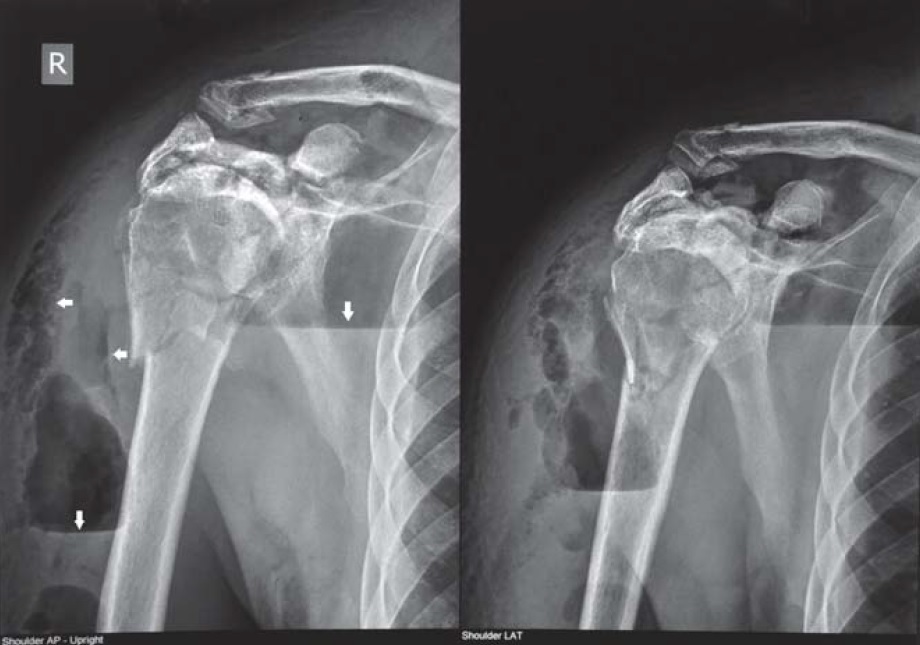Translate this page into:
Gas gangrene complicating an open fracture
2 Undergraduate Students, RG Kar Medical College and Hospital, 1, Khudiram Bose Sarani, Kolkata, West Bengal, India
3 Department of General Surgery, Institute of Post-Graduate Medical Education and Research (IPGMER), Kolkata, West Bengal, India
Corresponding Author:
Madhav Parik
Block C-111, Bangur Avenue,, Kolkata 700055, West Bengal
India
madhavparik@gmail.com
| How to cite this article: Mukherjee R, Parik M, Roy P, Mukhopadhyay G. Gas gangrene complicating an open fracture. Natl Med J India 2019;32:123 |
A 52-year-old man presented with shock 3 days after a neglected crush injury to the right shoulder. Examination revealed painful blackened sores with soft-tissue crepitus. X-ray [Figure - 1] showed multiple fractures around the shoulder and several subcutaneous gas-fluid levels (arrows). This was diagnosed as clostridial gas gangrene, to which the patient succumbed despite antibiotic therapy and wound debridement.
 |
| Figure 1: Radiograph of the right shoulder in anteroposterior and lateral views showing multiple fractures and air– fluid levels (arrows) |
Gas gangrene, also known as clostridial myonecrosis, is a moist gangrene caused by various clostridial species capable of thriving in conditions with low oxidation potential. Clostridium perfringens is the most common organism causing gas gangrene, while other organisms include Clostridium bifermentans, Clostridium septicum and Clostridium novyi, among others. Contamination of post-traumatic necrotic tissue with C. perfringens can lead to fulminant necrotizing infection which can develop within 6-8 hours. It can be followed rapidly by shock, organ failure and death. C. perfringens is a Gram-positive, sporeforming, non-motile organism. The organism is abundant in soil. Trauma introduces these organisms into deep tissues. Of the multiple endotoxins produced by the organism, alpha (phospholipase C) and delta (perfringolysin O) toxins are lethal, causing necrosis of muscle and subcutaneous fat, vascular thrombosis and glucose fermentation, producing gas gangrene. Approximately 90% of contaminated wounds have clostridial organisms, but <2% develop clostridial myonecrosis. It is an aggressive infection difficult to control even with antibiotics. Thus, in most cases, radical amputation is the best life-saving measure. However, early intervention can cure about 80% of cases of gas gangrene, with 15%-20% requiring amputation.
Fulltext Views
1,608
PDF downloads
786




